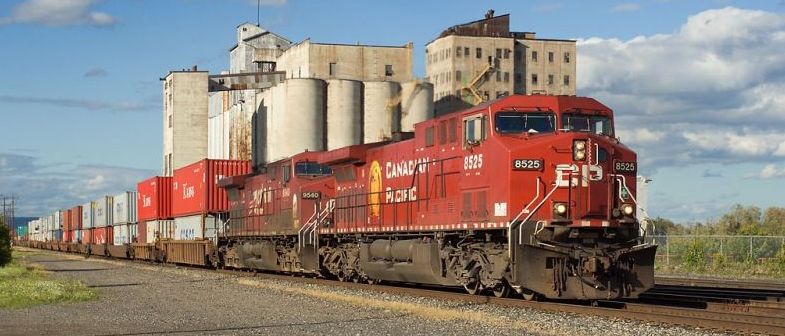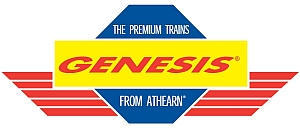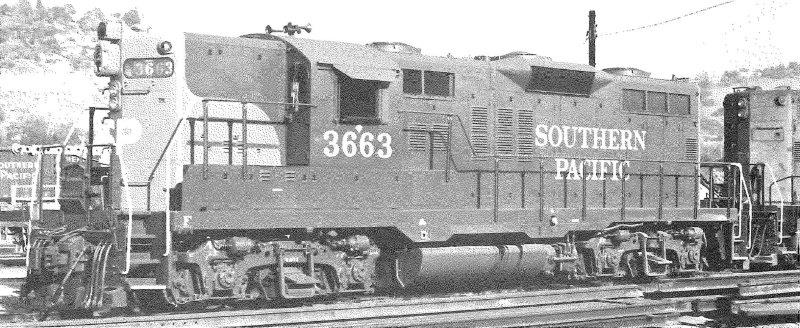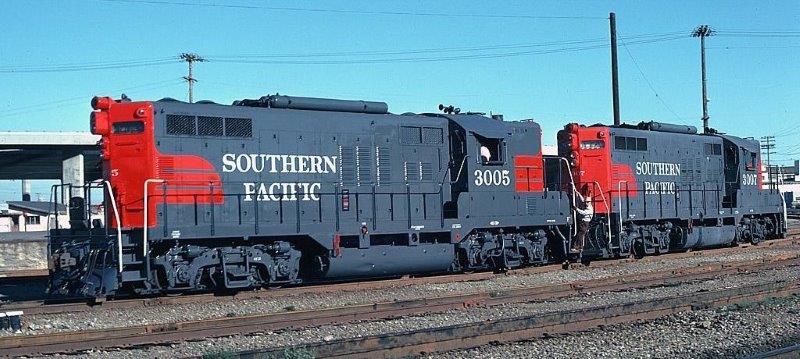
Train Addiction Help Line: 1.866.840.7777
Athearn Genesis - HO Scale - GP9 Diesel Locomotives - w/DCC & Sound - Canadian Pacific (CPR) #8495 - Grey/Red/Orange With Red/White Lettering (Era: 1950s-1970s) (SKU 141-78287)
Available On: December 1, 2020


GP7 - GP9

In 1939, the Electro-Motive Division of General Motors introduced the FT-tive. The success of the FT and the post-war successors, the F2 and F3, made EMD the largest locomotive builder by 1949. But in early 1949, there was a threat to EMD’s lead. The other builders were all offering a new type of locomo-tive, the road-switcher. As the name implies this was a locomotive that combined the features of a switch engine with those of a road freight engine. EMD’s first attempt at a road switcher , the BL-2, was not successful. The BL-2 was essentially an F3A with front and rear steps and walkways and had the upper parts of the car body sloped inward to improve visibility to the rear. EMD needed something better. In early 1949, the F3 series was upgraded to the F7 series. In October 1949, EMD introduced the GP7. The GP7 was powered by a 16-cylinder, 1,500 horsepower 567B diesel engine driving a D12 generator, which powered four D27 traction motors, exactly like the F7. The basic design, like almost all road switchers, followed the design of diesel switchers with the addition of a short hood instead of an end-cab. EMD also made the hoods full height to better accommodate the diesel engine and all of the mechanical and electrical components of a road engine. The first versions of the GP7 were more switchers than road units as they came with similar fuel tanks and were not equipped with dynamic brakes. In 1951, the second version was introduced with options like several sizes of fuel tanks, dynamic brakes, and steam generators. Fuel tank sizes included 800 gallon, 1,200 gallon, and 1,600 gal-lon tanks. When water tanks to supply the steam generators were added, there were options for tanks for 800 gallons of fuel and 800 gallons of water or for 1,100 gallons of each. These larger tanks required moving the air reservoirs to the roof to provide space for the tanks. These units became known as “torpedo boats.” Early GP7s had taller engine doors. On the Phase 2 engines with dynamic brakes, the doors under the dynamic brakes were shortened by four inches, leaving one tall door in front of the dynamic brakes. The Phase 3 engines used the shorter doors for all of the engine access doors regardless of dynamic brakes. Another variation was the cabless GP7B built for Santa Fe. GP7 production lasted from October 1949 until May 1954. There were 2,615 GP7s built for U.S. railroads, 112 for Canada, and 2 for Mexico. Major buyers of the GP7 were Santa Fe (244 and 5 GP7Bs), New York Central (218), Missouri Pacific (208), Chesapeake & Ohio (180) and Atlantic Coast Line (154). Other roads buying more than 100 units included Frisco (129), Seaboard Air Line (123), Chicago & Northwestern (121) and Rock Island (113).
PROTOTYPE INFO:
In 1949, EMD introduced the GP7. The basic design followed most diesel switchers with the addition of a short hood instead of an endcab. The hoods were also full height to better accommodate the diesel engine and mechanical and electrical components. In 1954 EMD upgraded the GP7 to become the 1,750 horsepower GP9. Externally, the first GP9s were virtually unchanged from the last GP7s. Later versions would include different louver arrangements and the last ones would come without the frame skirting. The GP9 was available with all of the fuel tank, steam generator, and dynamic brake options as the GP7, including “torpedo boats.” Many railroads chose to rebuild their GP7s and GP9s for continued service. Often times, it was cheaper to do this rather than purchasing brand-new locomotives.
LOCOMOTIVE FEATURES:
• Trainline and MU hoses
• Coupler cut levers
• Drop steps unless noted
• MU stands
• “Nub” style walkway tread
• Bell placement & type per prototype
• Fine-scale handrails for scale appearance
• Wire grab irons
• Lift rings
• Windshield wipers
• See through cab windows and full cab interior
• Etched metal radiator intake grilles and fan grilles
• Air tanks mounted below sill unless noted
• Detailed fuel tank with fuel fillers, fuel gauges, breather pipes, and retention tanks
• Blomberg-B trucks with appropriate bearing caps
• Sander lines
• Speed recorder unless noted
• Fully-assembled and ready-to-run
• DCC-ready features Quick Plug™ plug-and-play technology with 21-pin NEM connector
• Scaled from prototype resources including drawings, field measurements, photographs, and more
• Accurately-painted and printed paint schemes
• Body mounted McHenry operating scale knuckle couplers
• Genesis driveline with 5-pole skew wound motor, precision machined flywheels, and multi-link drivetrain for trouble free operation
• All-wheel drive with precision gears for smooth and quiet operation
• All-wheel electrical pickup provides reliable current flow
• Wheels with RP25 contours operate on all popular brands of track
• Bidirectional constant LED lighting so headlight brightness remains constant
• Heavy die-cast frame for greater traction and more pulling power
• Packaging securely holds the model for safe storage
• Replacement parts available
• Minimum radius: 18”
PRIMED FOR GRIME MODELS FEATURE:
• Duplicated look and feel of “In Service” equipment; “Tattered and Torn” just like the real thing
• Faded base colors matched to the prototype
• Patches applied and shaped per road number matching each corresponding side to the prototype
• Perfect starting point for adding grime and rust
SOUND EQUIPPED MODELS ALSO FEATURE:
• Onboard DCC decoder with SoundTraxx Tsunami2 sound
• Sound units operate in both DC and DCC
• Full DCC functions available when operated in DCC mode
• Engine, horn, and bell sounds work in DC
• All functions NMRA compatible in DCC mode
• Excellent Slow speed control
• Operating lighting functions with F5 and/or F6
• Program a multiple unit (MU) lashup with lead unit only horn, bell, and lights
• Many functions can be altered via Configuration Value (CV) changes
• CV chart included

SP COMMUTE FEATURES:
- Dual service units
- Steam Generator
- Roof mounted “Torpedo Tube” air tanks
- Cut side skirts
- Split water and diesel fuel tank
- “Wagon wheel” style antenna stand
- Nathan 5-Chime air horn
- Front and rear gyra light; (effect on DCC+Sound version only)
SP FEATURES:
- A number of GP9s escaped SP’s GRIP program. A few of them soldiered on well into the 1980s “as-built” later being renumbered into switchers. Most notable, SP #3663 and #3703 lasted nearly 20 years in scarlet and grey without ever being rebuilt.
- SP style numberboard access doors front and rear
- Conventional frame mounted air tanks
- Cut side skirts
- 2600 gallon diesel fuel tank
- Whip style antenna
- Nathan P3 air horn
- Front gyra light;
GTW FEATURES:
- Maple Leaf scheme
- “Barrel” style spark arrestors where appropriate
- Ratchet style brake stand
- Horns and bells mounted on long hood end per prototype
- Canadian style handrails
- Model set up for long hood forward operation per prototype.
- Alternate lowered drop step included
CV FEATURES:
- “Barrell” style spark arrestors
- Equipped with Dynamic Brakes
- Bells mounted on long hood end per prototype
- Model set up for long hood forward operation per prototype.
- Maple Leaf scheme
- Canadian style handrails
- Alternate lowered drop step included
GN FEATURES:
- Phase II body w/dynamic brakes
- Snowplow, both ends
- Firecracker antenna
- Bell mounted long hood end
- Great Northern specific toolbox side skirts – early version
- Spark arrestor style tall exhaust stack
- All weather cab window – included not applied
- Alternate lowered drop step included
CPR FEATURES:
- Passenger service
- Phase Ia
- Footboards with slotted steps
- “Pipe” handrail stanchions
- Inward railing bend at ends
- Front as-built Pyle-National “barrel” headlights
- Forward radiator intake grilles include striping trim
- Steam generator intake
- “Peacock” hand brake stand with brake wheel
- Rooftop mounted air tanks with cooling coil and piping
- Canadian-style winterization hatch
- CP passenger skirts with slots
- Four hose M.U. clusters with silver glad-hands
- Early coupler cut levers
- Drop step mounted in the vertical position
- Dual early M.U. stand with M.U. and field loop connections
- Slotted cab steps
- Standard battery box doors
- Raised seam and rectangular vent on right side of nose
- Separately applied windshield wipers
- See through cab windows
- Early short hood forward cab interior
- Cab side panel with gutter
- Mirrors/wind deflectors mounted fore of cab side windows
- Nathan K-3 air horn
- Large Sinclair antenna
- 1200+1200 gallon fuel tank
#8506 & 8512:
- Later scheme with script lettering
#8487 & 8495:
- Earlier scheme with block lettering. No steam generator. Standard air tanks & skirts.
Order Due Date: December 27, 2019
Anticipated Delivery Date: December 2020

$299.98 US


